Sapa City Vietnam is a beautiful town in Northwest Vietnam, known for its cool weather and stunning views. But what makes Sapa even more special is its amazing Sapa food. The local dishes here are full of flavor and tell the story of the ethnic groups living in the mountains.
If you love food, Sapa will surprise you with its unique tastes. From warm noodle soups to grilled meats and colorful sticky rice, every dish has something special. Let’s explore the best Sapa food you must try when visiting!
Must-Eat Sapa Food for Every Traveler
1. Con Sui (Cốn Sủi)

One of the most comforting Sapa food specialties is Con Sui, a noodle soup that warms both body and soul on chilly mountain mornings, especially in
Vietnam Sapa Winter. Unlike regular Pho, this dish features a thicker, more robust broth that clings to the noodles. The soup is generously topped with thin slices of pork and beef, half a soft-boiled egg, crunchy fried shallots, roasted peanuts, and sometimes crispy sweet potato strips for extra texture. The broth simmers for hours with aromatic spices, resulting in a rich, slightly sweet base that perfectly balances the savory meats and crunchy toppings.
Locals often enjoy this dish for breakfast, fueling up for a day of trekking through
Sapa rice fields. Small family-run eateries throughout town serve their own versions, each with subtle variations in seasoning and toppings that make every bowl a unique experience.
2. Sour Pho (Phở Chua)

While
Pho is Vietnam’s most famous dish, Sapa puts its own mountain twist on this beloved noodle soup. Sour Pho is a cold noodle with bright, tangy flavors. The dish starts with wide rice noodles that provide a soft, chewy base for the other ingredients. These include tender slices of grilled pork, tart green mango strips, crunchy pickled vegetables, fragrant herbs, and roasted peanuts for richness.
The magic lies in the dressing – a perfectly balanced mix of fish sauce, lime juice, sugar, and chili that coats every strand of noodle. Many small stalls in Sapa’s markets serve this dish, and watching the vendors expertly assemble each bowl is part of the experience. Don’t be surprised if you find yourself craving this refreshing dish long after leaving Sapa.
3. Bun Cha Sapa (Bún Chả)

While
Hanoi has its famous Bun Cha (grilled pork with noodles), Sapa’s food version tells a completely different story. This Sapa food specialty is a hot noodle soup that has a distinctive tangy-sweet flavor from tomatoes and fermented rice, with depth from long-simmered pork bones. Floating in this aromatic liquid are various pork delights – crispy fried spring rolls, grilled pork patties, fish cakes, and sometimes even blood sausage for the adventurous eater.
Many small restaurants around Sapa town serve this as their daily special, often accompanied by fiery chili sauce for those who want an extra kick. It’s the perfect meal after a day of exploring Sapa’s cool mountain air.
4. Salmon (Cá Hồi)

Surprisingly, one of the most celebrated Sapa food items isn’t something you’d expect to find in the mountains – fresh salmon. Thanks to Sapa’s cool climate and crystal-clear streams, local farmers have successfully raised high-quality salmon that rivals ocean-caught varieties.
At Sapa restaurants, you’ll find salmon served multiple ways. For purity of flavor, nothing beats salmon sashimi – thinly sliced and served with wasabi and soy sauce to highlight its natural sweetness. Grilled salmon develops a wonderful crispy skin while keeping the interior moist and flaky. But perhaps the most memorable way to enjoy Sapa salmon is in a hotpot, where diners cook thin slices of fish in a bubbling broth flavored with tomatoes, herbs, and local spices. Many restaurants near Thac Bac (
Silver Waterfall) specialize in salmon dishes, often with views of the fish farms where your meal was raised.
5. Black Chicken (Gà Đen)

One of the most intriguing Sapa food offerings is black chicken, known locally as Gà Đen or Gà Ác. This isn’t your ordinary poultry – every part of the bird, from its feathers to its skin, meat, and even bones, is a deep black color due to a genetic trait. The H’mong and Dao ethnic minorities have raised these chickens for generations, valuing them both for their unique flavor and medicinal properties in traditional medicine.
The chickens are smaller than regular varieties, with meat that’s remarkably firm and flavorful. One classic dish is Black Chicken Herbal Soup (Gà Tần), slowly simmered with medicinal roots and herbs that create an aromatic, nourishing broth. The soup is believed to boost energy and immunity, making it a favorite among locals and visitors alike.
6. Piglet (Lợn Cắp Nách)

One of the most iconic Sapa food experiences is trying the region’s famous “piglet under the arm” (lợn cắp nách). These small black pigs, weighing only about 5-6kg, get their unique name from the way local farmers carry them to market, tucked under one arm. Raised completely free-range in the mountain forests, these pigs develop incredibly flavorful meat with the perfect balance of lean muscle and sweet fat from their natural diet of forest roots and plants.
Served with freshly steamed rice and a side of fermented mustard greens, this dish perfectly represents the essence of Sapa food – simple preparations highlighting extraordinary local ingredients. The communal way it’s served, with everyone sharing pieces of the whole roasted pig, makes it a particularly social and memorable dining experience.
7. Thang Co (Thắng Cố)

No exploration of Sapa food would be complete without mentioning Thang Co, the signature dish of the H’mong people that challenges and rewards adventurous eaters. This hearty stew, originally made with horse meat (though now often prepared with buffalo or beef), showcases the nose-to-tail cooking philosophy of mountain communities. Large chunks of meat, organs, and bones simmer for hours with a distinctive blend of a dozen mountain herbs and spices, including cardamom, cinnamon, and star anise.
Served in a communal hotpot, Thang Co has a rich, gamey flavor with layers of herbal complexity that develop as it simmers. The broth takes on a slightly viscous quality from the collagen-rich cuts, while the variety of meats and organs provides an exciting textural journey. Traditional accompaniments include bitter greens, mustard leaves, and corn wine to cut through the richness.
The best versions can be found at small stalls in Sapa’s markets or in H’mong villages, where it’s often cooked in massive cast-iron pots over wood fires. For those willing to step outside their culinary comfort zone, it’s possibly the most culturally immersive Sapa food experience available.
8. Five-color sticky rice (Xôi Ngũ Sắc)

This stunning Sapa food specialty showcases the culinary artistry of the Tay ethnic group. Each colour comes from natural dyes extracted from local plants and carries cultural significance, representing the five elements. The deep purple comes from magenta plant leaves, green from pandan, yellow from turmeric, red from gac fruit, while white remains the natural rice color. While visually spectacular, what makes this dish truly special is its delicate flavor, slightly sweet with faint herbal notes from the natural colorings, often served with a sprinkle of sesame salt for contrast.
It’s commonly served at important celebrations and festivals, making it not just a meal but an expression of Tay cultural identity. Many visitors buy it as both a snack and a photograph-worthy example of Sapa food artistry.
9. Chestnut cake (Bánh Hạt Dẻ)

As autumn arrives in Sapa, the hillsides turn golden with ripening chestnuts, inspiring one of the region’s most beloved desserts. Chestnut cake beautifully represents how Sapa food transforms simple local ingredients into something extraordinary. The cakes start with fresh chestnuts that are roasted, peeled, and then slowly simmered with a touch of mountain honey until they form a velvety paste. This rich filling gets wrapped in a delicate rice flour dough before being pan-fried to golden perfection. The contrast between the crispy exterior and the sweet, nutty interior makes these cakes irresistible.
You’ll find these treats being sold by street vendors throughout
Sapa town, especially near popular viewpoints where visitors pause to take in the scenery. Paired with a cup of locally grown tea, they make the perfect afternoon snack after a morning of trekking.
10. Men men (Mèn Mén)

This humble yet fascinating Sapa food staple reveals the ingenuity of mountain cuisine. Men Men is steamed cornmeal, but calling it that doesn’t do justice to the careful preparation that transforms simple corn into something special. The H’mong people use an ancient variety of corn grown at high altitudes, which they stone-grind into flour before mixing with just the right amount of water to create a crumbly yet moist texture.
The cornmeal gets steamed twice in bamboo baskets – first to cook it through, then a second time with a special stirring technique that creates light, fluffy grains. The result has an almost polenta-like consistency but with more texture and a wonderful toasted corn flavor. Traditionally served with stir-fried wild mushrooms or bitter greens, it’s a dish that showcases how mountain communities create satisfying meals from basic ingredients.
What makes Men Men truly special is its cultural significance – it’s considered the definitive comfort food of the H’mong people, often served at family gatherings and celebrations. The preparation varies slightly from village to village, with each family having their own preferred texture and accompaniments, making each tasting a unique experience.
11. Lam rice (Cơm Lam)
One of the most iconic Sapa food presentations is Cơm Lam – rice cooked inside bamboo tubes that infuses every grain with a subtle woody aroma. This ingenious cooking method dates back generations among the mountain tribes, originally developed as a portable meal for long hunting trips or days working in distant fields.

As the bamboo chars, the rice inside steams to perfection, absorbing delicate vegetal notes from the bamboo. To serve, the charred bamboo is split open, revealing the cylindrical rice loaf that’s fragrant and slightly sweet. The traditional way to eat it is by pinching off pieces with your fingers and dipping them in sesame salt or enjoying them with grilled meats.
Many trekking tours include it as part of their packed lunches, as the bamboo packaging makes it perfectly portable. Beyond being delicious, it’s a wonderful example of how Sapa food traditions make creative use of natural materials.
12. Bitter Bamboo Shoot Spring Rolls (Nem Măng Đắng)

The Tay ethnic group contributes this distinctive Sapa food specialty that beautifully balances flavors and textures. These spring rolls feature a filling of finely shredded bitter bamboo shoots mixed with minced pork, wood ear mushrooms, and aromatic herbs, all wrapped in crispy rice paper and fried to golden perfection. The “bitter” in the name might sound off-putting, but the flavor is pleasantly earthy with just a hint of pleasant bitterness that makes these rolls uniquely addictive.
>>> Explore more about the Tay People to know more about their vibrant culture!
Many small family restaurants in Sapa’s Tay villages serve these spring rolls made from generations-old recipes. The contrast between the crispy exterior and the complex interior makes them a must-try for anyone exploring the diversity of Sapa food.
13. Sour salted pork (Thịt Lợn Muối Chua)

This traditional Sapa food preparation showcases mountain preservation techniques developed before refrigeration. Pork belly is cured with a mixture of salt, rice wine, and local herbs before being aged in clay jars for several weeks. The result is meat with a firm texture and complex flavor – salty, slightly sour, and deeply savory with herbal undertones.
Served in thin slices, the pork has a translucent quality and a satisfying chewiness. Locals enjoy it as both an accompaniment to rice meals and as a drinking snack paired with corn wine.
What makes this dish special is how it captures the essence of Sapa’s food preservation traditions. Many families still make their own following secret recipes passed down through generations. Visitors can find it at local markets, often sold alongside other preserved mountain specialties. It also makes an excellent edible souvenir – properly packaged, it keeps well for bringing a taste of Sapa food back home.
Final Thoughts on Sapa Food
Exploring Sapas food is like taking a journey through the region’s culture and landscapes. Each dish tells a story of ethnic traditions, mountain farming, and creative adaptation to the local environment. From the hearty stews that warm cold nights to the delicate rice preparations that showcase natural beauty, Sapa’s cuisine offers endless discoveries for curious food lovers.
>>> Read More: Top 15+ Sapa Restaurant Picks: Where to Enjoy Authentic Local Cuisine
The best way to experience it is adventurously – trying unfamiliar Sapa dishes, visiting local markets, and perhaps even joining a cooking class to learn the secrets behind these remarkable flavors. Whether you’re sampling grilled specialties at the night market or sharing a hotpot with new friends, Sapa food creates memories as lasting as the region’s stunning mountain vistas.
If you want to experience not only the food but also the heart of Sapa, join a Sapa tour with YESD. With a focus on responsible travel and authentic cultural exchange, YESD’s tours offer you a deeper look into local life while supporting the communities you visit. Let your Sapa journey be more than a visit and make it a meaningful connection!
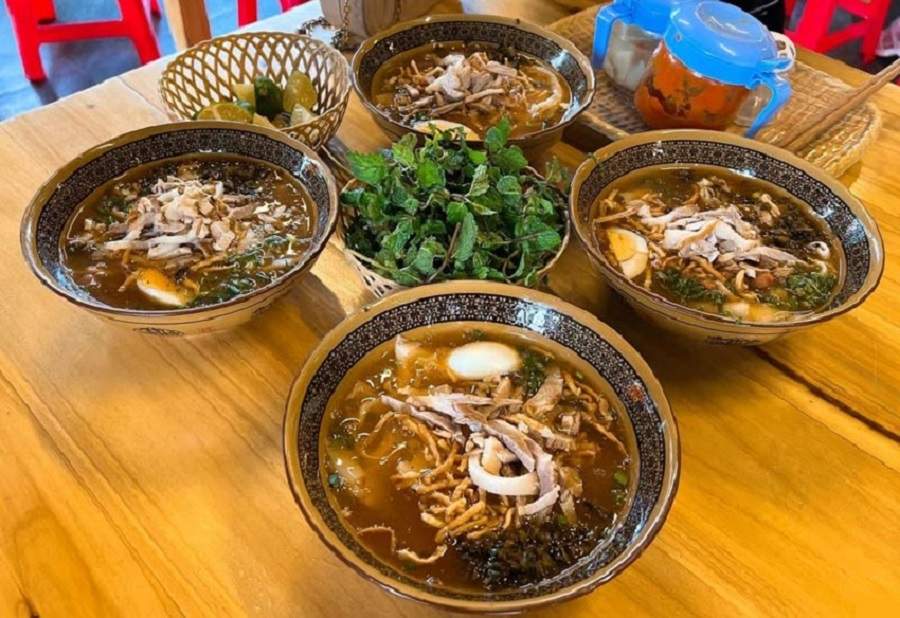 One of the most comforting Sapa food specialties is Con Sui, a noodle soup that warms both body and soul on chilly mountain mornings, especially in Vietnam Sapa Winter. Unlike regular Pho, this dish features a thicker, more robust broth that clings to the noodles. The soup is generously topped with thin slices of pork and beef, half a soft-boiled egg, crunchy fried shallots, roasted peanuts, and sometimes crispy sweet potato strips for extra texture. The broth simmers for hours with aromatic spices, resulting in a rich, slightly sweet base that perfectly balances the savory meats and crunchy toppings.Locals often enjoy this dish for breakfast, fueling up for a day of trekking through Sapa rice fields. Small family-run eateries throughout town serve their own versions, each with subtle variations in seasoning and toppings that make every bowl a unique experience.
One of the most comforting Sapa food specialties is Con Sui, a noodle soup that warms both body and soul on chilly mountain mornings, especially in Vietnam Sapa Winter. Unlike regular Pho, this dish features a thicker, more robust broth that clings to the noodles. The soup is generously topped with thin slices of pork and beef, half a soft-boiled egg, crunchy fried shallots, roasted peanuts, and sometimes crispy sweet potato strips for extra texture. The broth simmers for hours with aromatic spices, resulting in a rich, slightly sweet base that perfectly balances the savory meats and crunchy toppings.Locals often enjoy this dish for breakfast, fueling up for a day of trekking through Sapa rice fields. Small family-run eateries throughout town serve their own versions, each with subtle variations in seasoning and toppings that make every bowl a unique experience. While Pho is Vietnam’s most famous dish, Sapa puts its own mountain twist on this beloved noodle soup. Sour Pho is a cold noodle with bright, tangy flavors. The dish starts with wide rice noodles that provide a soft, chewy base for the other ingredients. These include tender slices of grilled pork, tart green mango strips, crunchy pickled vegetables, fragrant herbs, and roasted peanuts for richness.The magic lies in the dressing – a perfectly balanced mix of fish sauce, lime juice, sugar, and chili that coats every strand of noodle. Many small stalls in Sapa’s markets serve this dish, and watching the vendors expertly assemble each bowl is part of the experience. Don’t be surprised if you find yourself craving this refreshing dish long after leaving Sapa.
While Pho is Vietnam’s most famous dish, Sapa puts its own mountain twist on this beloved noodle soup. Sour Pho is a cold noodle with bright, tangy flavors. The dish starts with wide rice noodles that provide a soft, chewy base for the other ingredients. These include tender slices of grilled pork, tart green mango strips, crunchy pickled vegetables, fragrant herbs, and roasted peanuts for richness.The magic lies in the dressing – a perfectly balanced mix of fish sauce, lime juice, sugar, and chili that coats every strand of noodle. Many small stalls in Sapa’s markets serve this dish, and watching the vendors expertly assemble each bowl is part of the experience. Don’t be surprised if you find yourself craving this refreshing dish long after leaving Sapa.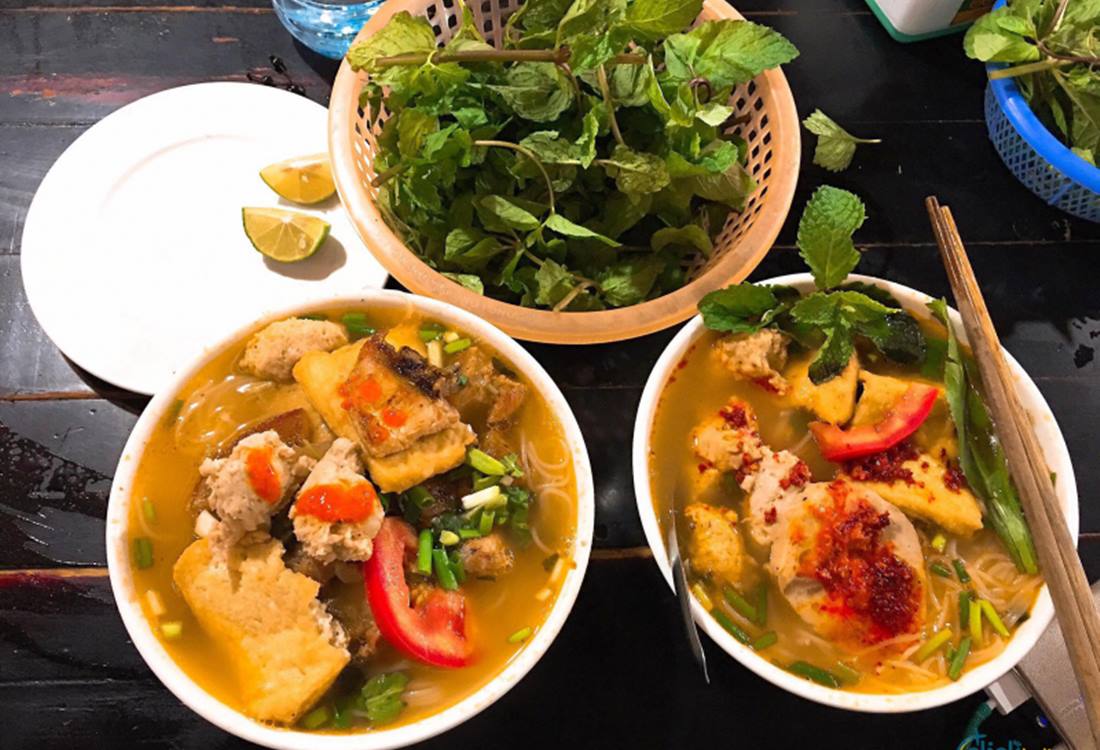 While Hanoi has its famous Bun Cha (grilled pork with noodles), Sapa’s food version tells a completely different story. This Sapa food specialty is a hot noodle soup that has a distinctive tangy-sweet flavor from tomatoes and fermented rice, with depth from long-simmered pork bones. Floating in this aromatic liquid are various pork delights – crispy fried spring rolls, grilled pork patties, fish cakes, and sometimes even blood sausage for the adventurous eater.Many small restaurants around Sapa town serve this as their daily special, often accompanied by fiery chili sauce for those who want an extra kick. It’s the perfect meal after a day of exploring Sapa’s cool mountain air.
While Hanoi has its famous Bun Cha (grilled pork with noodles), Sapa’s food version tells a completely different story. This Sapa food specialty is a hot noodle soup that has a distinctive tangy-sweet flavor from tomatoes and fermented rice, with depth from long-simmered pork bones. Floating in this aromatic liquid are various pork delights – crispy fried spring rolls, grilled pork patties, fish cakes, and sometimes even blood sausage for the adventurous eater.Many small restaurants around Sapa town serve this as their daily special, often accompanied by fiery chili sauce for those who want an extra kick. It’s the perfect meal after a day of exploring Sapa’s cool mountain air.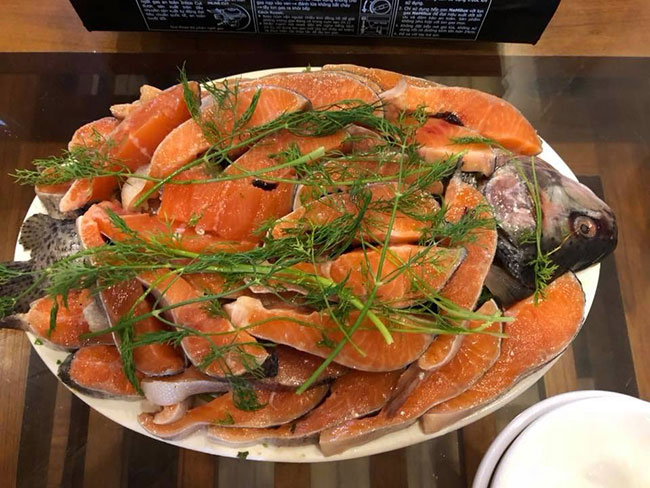 Surprisingly, one of the most celebrated Sapa food items isn’t something you’d expect to find in the mountains – fresh salmon. Thanks to Sapa’s cool climate and crystal-clear streams, local farmers have successfully raised high-quality salmon that rivals ocean-caught varieties.At Sapa restaurants, you’ll find salmon served multiple ways. For purity of flavor, nothing beats salmon sashimi – thinly sliced and served with wasabi and soy sauce to highlight its natural sweetness. Grilled salmon develops a wonderful crispy skin while keeping the interior moist and flaky. But perhaps the most memorable way to enjoy Sapa salmon is in a hotpot, where diners cook thin slices of fish in a bubbling broth flavored with tomatoes, herbs, and local spices. Many restaurants near Thac Bac (Silver Waterfall) specialize in salmon dishes, often with views of the fish farms where your meal was raised.
Surprisingly, one of the most celebrated Sapa food items isn’t something you’d expect to find in the mountains – fresh salmon. Thanks to Sapa’s cool climate and crystal-clear streams, local farmers have successfully raised high-quality salmon that rivals ocean-caught varieties.At Sapa restaurants, you’ll find salmon served multiple ways. For purity of flavor, nothing beats salmon sashimi – thinly sliced and served with wasabi and soy sauce to highlight its natural sweetness. Grilled salmon develops a wonderful crispy skin while keeping the interior moist and flaky. But perhaps the most memorable way to enjoy Sapa salmon is in a hotpot, where diners cook thin slices of fish in a bubbling broth flavored with tomatoes, herbs, and local spices. Many restaurants near Thac Bac (Silver Waterfall) specialize in salmon dishes, often with views of the fish farms where your meal was raised. One of the most intriguing Sapa food offerings is black chicken, known locally as Gà Đen or Gà Ác. This isn’t your ordinary poultry – every part of the bird, from its feathers to its skin, meat, and even bones, is a deep black color due to a genetic trait. The H’mong and Dao ethnic minorities have raised these chickens for generations, valuing them both for their unique flavor and medicinal properties in traditional medicine.The chickens are smaller than regular varieties, with meat that’s remarkably firm and flavorful. One classic dish is Black Chicken Herbal Soup (Gà Tần), slowly simmered with medicinal roots and herbs that create an aromatic, nourishing broth. The soup is believed to boost energy and immunity, making it a favorite among locals and visitors alike.
One of the most intriguing Sapa food offerings is black chicken, known locally as Gà Đen or Gà Ác. This isn’t your ordinary poultry – every part of the bird, from its feathers to its skin, meat, and even bones, is a deep black color due to a genetic trait. The H’mong and Dao ethnic minorities have raised these chickens for generations, valuing them both for their unique flavor and medicinal properties in traditional medicine.The chickens are smaller than regular varieties, with meat that’s remarkably firm and flavorful. One classic dish is Black Chicken Herbal Soup (Gà Tần), slowly simmered with medicinal roots and herbs that create an aromatic, nourishing broth. The soup is believed to boost energy and immunity, making it a favorite among locals and visitors alike.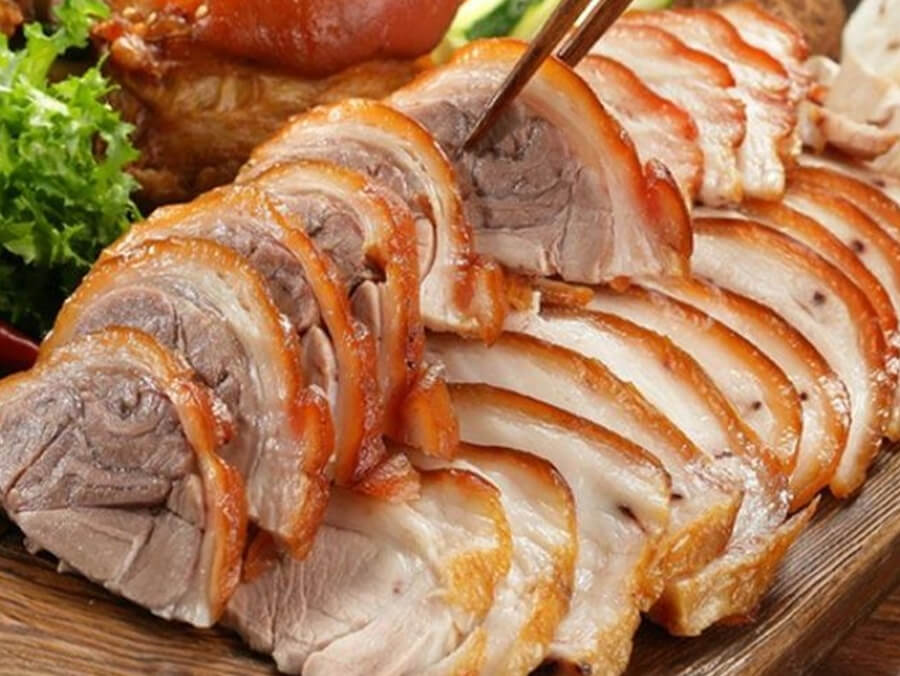 One of the most iconic Sapa food experiences is trying the region’s famous “piglet under the arm” (lợn cắp nách). These small black pigs, weighing only about 5-6kg, get their unique name from the way local farmers carry them to market, tucked under one arm. Raised completely free-range in the mountain forests, these pigs develop incredibly flavorful meat with the perfect balance of lean muscle and sweet fat from their natural diet of forest roots and plants.Served with freshly steamed rice and a side of fermented mustard greens, this dish perfectly represents the essence of Sapa food – simple preparations highlighting extraordinary local ingredients. The communal way it’s served, with everyone sharing pieces of the whole roasted pig, makes it a particularly social and memorable dining experience.
One of the most iconic Sapa food experiences is trying the region’s famous “piglet under the arm” (lợn cắp nách). These small black pigs, weighing only about 5-6kg, get their unique name from the way local farmers carry them to market, tucked under one arm. Raised completely free-range in the mountain forests, these pigs develop incredibly flavorful meat with the perfect balance of lean muscle and sweet fat from their natural diet of forest roots and plants.Served with freshly steamed rice and a side of fermented mustard greens, this dish perfectly represents the essence of Sapa food – simple preparations highlighting extraordinary local ingredients. The communal way it’s served, with everyone sharing pieces of the whole roasted pig, makes it a particularly social and memorable dining experience.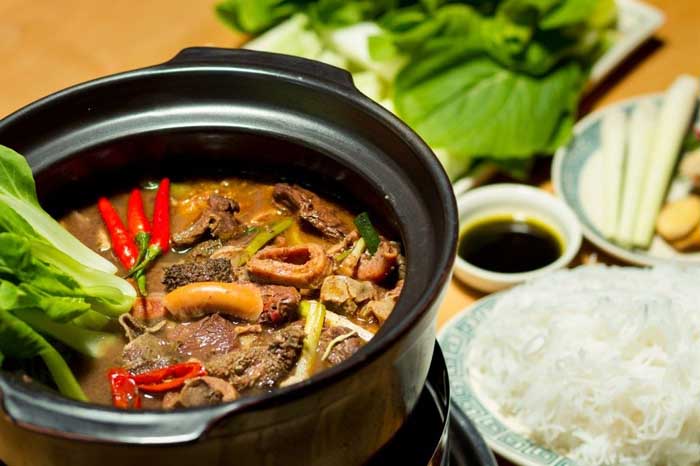 No exploration of Sapa food would be complete without mentioning Thang Co, the signature dish of the H’mong people that challenges and rewards adventurous eaters. This hearty stew, originally made with horse meat (though now often prepared with buffalo or beef), showcases the nose-to-tail cooking philosophy of mountain communities. Large chunks of meat, organs, and bones simmer for hours with a distinctive blend of a dozen mountain herbs and spices, including cardamom, cinnamon, and star anise.Served in a communal hotpot, Thang Co has a rich, gamey flavor with layers of herbal complexity that develop as it simmers. The broth takes on a slightly viscous quality from the collagen-rich cuts, while the variety of meats and organs provides an exciting textural journey. Traditional accompaniments include bitter greens, mustard leaves, and corn wine to cut through the richness.The best versions can be found at small stalls in Sapa’s markets or in H’mong villages, where it’s often cooked in massive cast-iron pots over wood fires. For those willing to step outside their culinary comfort zone, it’s possibly the most culturally immersive Sapa food experience available.
No exploration of Sapa food would be complete without mentioning Thang Co, the signature dish of the H’mong people that challenges and rewards adventurous eaters. This hearty stew, originally made with horse meat (though now often prepared with buffalo or beef), showcases the nose-to-tail cooking philosophy of mountain communities. Large chunks of meat, organs, and bones simmer for hours with a distinctive blend of a dozen mountain herbs and spices, including cardamom, cinnamon, and star anise.Served in a communal hotpot, Thang Co has a rich, gamey flavor with layers of herbal complexity that develop as it simmers. The broth takes on a slightly viscous quality from the collagen-rich cuts, while the variety of meats and organs provides an exciting textural journey. Traditional accompaniments include bitter greens, mustard leaves, and corn wine to cut through the richness.The best versions can be found at small stalls in Sapa’s markets or in H’mong villages, where it’s often cooked in massive cast-iron pots over wood fires. For those willing to step outside their culinary comfort zone, it’s possibly the most culturally immersive Sapa food experience available.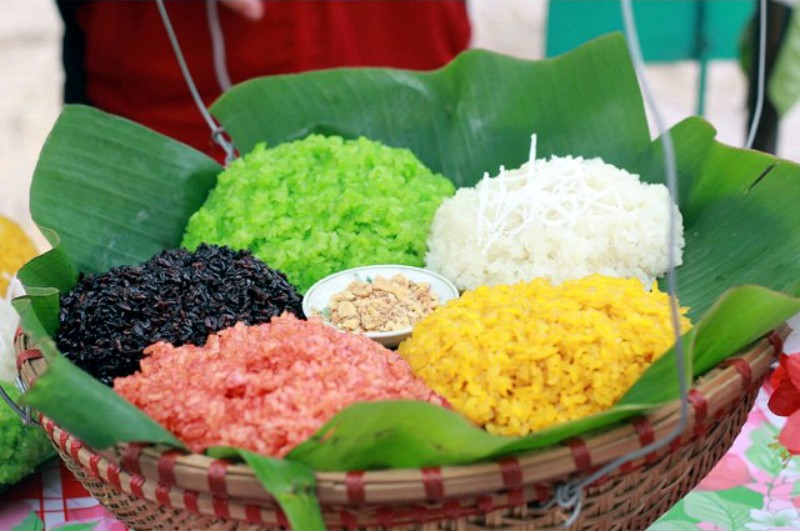 This stunning Sapa food specialty showcases the culinary artistry of the Tay ethnic group. Each colour comes from natural dyes extracted from local plants and carries cultural significance, representing the five elements. The deep purple comes from magenta plant leaves, green from pandan, yellow from turmeric, red from gac fruit, while white remains the natural rice color. While visually spectacular, what makes this dish truly special is its delicate flavor, slightly sweet with faint herbal notes from the natural colorings, often served with a sprinkle of sesame salt for contrast.It’s commonly served at important celebrations and festivals, making it not just a meal but an expression of Tay cultural identity. Many visitors buy it as both a snack and a photograph-worthy example of Sapa food artistry.
This stunning Sapa food specialty showcases the culinary artistry of the Tay ethnic group. Each colour comes from natural dyes extracted from local plants and carries cultural significance, representing the five elements. The deep purple comes from magenta plant leaves, green from pandan, yellow from turmeric, red from gac fruit, while white remains the natural rice color. While visually spectacular, what makes this dish truly special is its delicate flavor, slightly sweet with faint herbal notes from the natural colorings, often served with a sprinkle of sesame salt for contrast.It’s commonly served at important celebrations and festivals, making it not just a meal but an expression of Tay cultural identity. Many visitors buy it as both a snack and a photograph-worthy example of Sapa food artistry.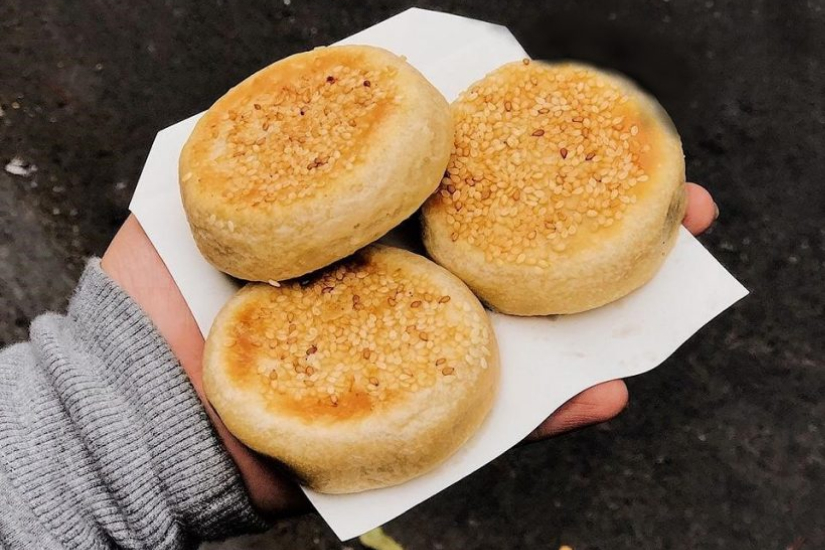 As autumn arrives in Sapa, the hillsides turn golden with ripening chestnuts, inspiring one of the region’s most beloved desserts. Chestnut cake beautifully represents how Sapa food transforms simple local ingredients into something extraordinary. The cakes start with fresh chestnuts that are roasted, peeled, and then slowly simmered with a touch of mountain honey until they form a velvety paste. This rich filling gets wrapped in a delicate rice flour dough before being pan-fried to golden perfection. The contrast between the crispy exterior and the sweet, nutty interior makes these cakes irresistible.You’ll find these treats being sold by street vendors throughout Sapa town, especially near popular viewpoints where visitors pause to take in the scenery. Paired with a cup of locally grown tea, they make the perfect afternoon snack after a morning of trekking.
As autumn arrives in Sapa, the hillsides turn golden with ripening chestnuts, inspiring one of the region’s most beloved desserts. Chestnut cake beautifully represents how Sapa food transforms simple local ingredients into something extraordinary. The cakes start with fresh chestnuts that are roasted, peeled, and then slowly simmered with a touch of mountain honey until they form a velvety paste. This rich filling gets wrapped in a delicate rice flour dough before being pan-fried to golden perfection. The contrast between the crispy exterior and the sweet, nutty interior makes these cakes irresistible.You’ll find these treats being sold by street vendors throughout Sapa town, especially near popular viewpoints where visitors pause to take in the scenery. Paired with a cup of locally grown tea, they make the perfect afternoon snack after a morning of trekking. This humble yet fascinating Sapa food staple reveals the ingenuity of mountain cuisine. Men Men is steamed cornmeal, but calling it that doesn’t do justice to the careful preparation that transforms simple corn into something special. The H’mong people use an ancient variety of corn grown at high altitudes, which they stone-grind into flour before mixing with just the right amount of water to create a crumbly yet moist texture.The cornmeal gets steamed twice in bamboo baskets – first to cook it through, then a second time with a special stirring technique that creates light, fluffy grains. The result has an almost polenta-like consistency but with more texture and a wonderful toasted corn flavor. Traditionally served with stir-fried wild mushrooms or bitter greens, it’s a dish that showcases how mountain communities create satisfying meals from basic ingredients.What makes Men Men truly special is its cultural significance – it’s considered the definitive comfort food of the H’mong people, often served at family gatherings and celebrations. The preparation varies slightly from village to village, with each family having their own preferred texture and accompaniments, making each tasting a unique experience.
This humble yet fascinating Sapa food staple reveals the ingenuity of mountain cuisine. Men Men is steamed cornmeal, but calling it that doesn’t do justice to the careful preparation that transforms simple corn into something special. The H’mong people use an ancient variety of corn grown at high altitudes, which they stone-grind into flour before mixing with just the right amount of water to create a crumbly yet moist texture.The cornmeal gets steamed twice in bamboo baskets – first to cook it through, then a second time with a special stirring technique that creates light, fluffy grains. The result has an almost polenta-like consistency but with more texture and a wonderful toasted corn flavor. Traditionally served with stir-fried wild mushrooms or bitter greens, it’s a dish that showcases how mountain communities create satisfying meals from basic ingredients.What makes Men Men truly special is its cultural significance – it’s considered the definitive comfort food of the H’mong people, often served at family gatherings and celebrations. The preparation varies slightly from village to village, with each family having their own preferred texture and accompaniments, making each tasting a unique experience.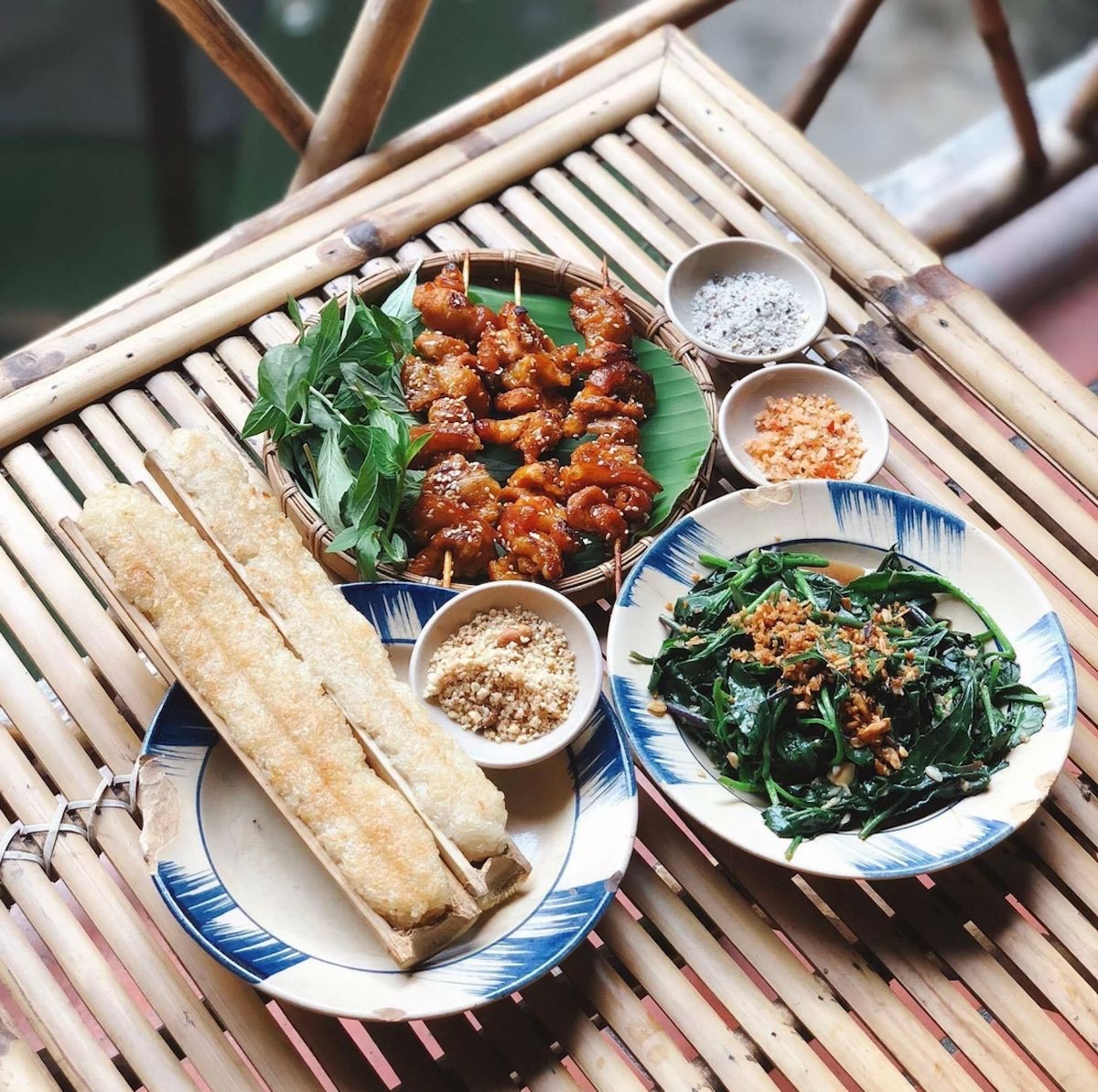 As the bamboo chars, the rice inside steams to perfection, absorbing delicate vegetal notes from the bamboo. To serve, the charred bamboo is split open, revealing the cylindrical rice loaf that’s fragrant and slightly sweet. The traditional way to eat it is by pinching off pieces with your fingers and dipping them in sesame salt or enjoying them with grilled meats.Many trekking tours include it as part of their packed lunches, as the bamboo packaging makes it perfectly portable. Beyond being delicious, it’s a wonderful example of how Sapa food traditions make creative use of natural materials.
As the bamboo chars, the rice inside steams to perfection, absorbing delicate vegetal notes from the bamboo. To serve, the charred bamboo is split open, revealing the cylindrical rice loaf that’s fragrant and slightly sweet. The traditional way to eat it is by pinching off pieces with your fingers and dipping them in sesame salt or enjoying them with grilled meats.Many trekking tours include it as part of their packed lunches, as the bamboo packaging makes it perfectly portable. Beyond being delicious, it’s a wonderful example of how Sapa food traditions make creative use of natural materials.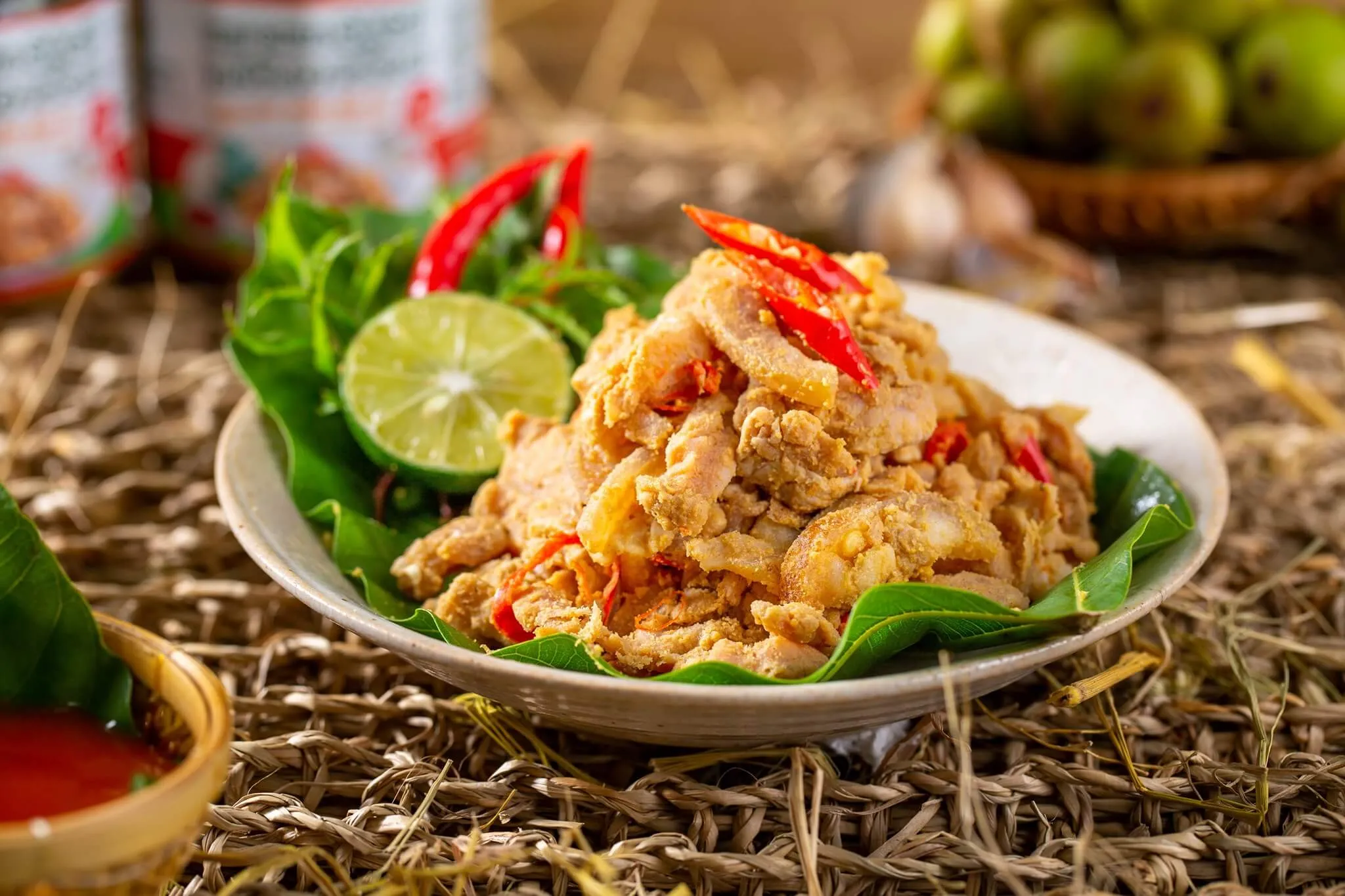 This traditional Sapa food preparation showcases mountain preservation techniques developed before refrigeration. Pork belly is cured with a mixture of salt, rice wine, and local herbs before being aged in clay jars for several weeks. The result is meat with a firm texture and complex flavor – salty, slightly sour, and deeply savory with herbal undertones.Served in thin slices, the pork has a translucent quality and a satisfying chewiness. Locals enjoy it as both an accompaniment to rice meals and as a drinking snack paired with corn wine.What makes this dish special is how it captures the essence of Sapa’s food preservation traditions. Many families still make their own following secret recipes passed down through generations. Visitors can find it at local markets, often sold alongside other preserved mountain specialties. It also makes an excellent edible souvenir – properly packaged, it keeps well for bringing a taste of Sapa food back home.
This traditional Sapa food preparation showcases mountain preservation techniques developed before refrigeration. Pork belly is cured with a mixture of salt, rice wine, and local herbs before being aged in clay jars for several weeks. The result is meat with a firm texture and complex flavor – salty, slightly sour, and deeply savory with herbal undertones.Served in thin slices, the pork has a translucent quality and a satisfying chewiness. Locals enjoy it as both an accompaniment to rice meals and as a drinking snack paired with corn wine.What makes this dish special is how it captures the essence of Sapa’s food preservation traditions. Many families still make their own following secret recipes passed down through generations. Visitors can find it at local markets, often sold alongside other preserved mountain specialties. It also makes an excellent edible souvenir – properly packaged, it keeps well for bringing a taste of Sapa food back home.